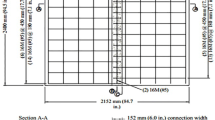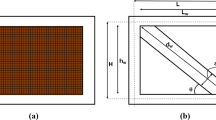Abstract
A new 3D finite element model is presented to analyze creep in reinforced concrete (RC) and prestressed concrete (PC) bridges. The proposed hybrid model uses a 12-node solid element to simulate concrete and a 2-node truss element to simulate rebars, the volume occupied by rebars in concrete and ducts. Structures are meshed with a special meshing technique and truss element connects with solid element through non-nodal connection. In this study, an additional two-node spatial truss element with a negative area is introduced to consider the non-negligible influence of rebar ducts in concrete and obtain a more precise and efficient simulation of RC and PC bridges. Different uses of the truss element with a negative area in both RC and PC structures are also explained, and two drop-frame cases and associated construction stages are investigated to validate the applicability of this model. The construction process analysis of a simplified PC continuous rigid frame bridge is also conducted in this study to further demonstrate the ability of the newly developed program to capture shear lag effect. The results show that the proposed model with negative-area truss elements enables the long-term behavior of RC and PC structures to be effectively predicted.
Similar content being viewed by others
References
ACI (1992) Prediction of creep, shrinkage, and temperature effects in concrete structures. ACI 209R-92, American Concrete Institute, Farmington Hills, MI, USA
Bazant ZP, Jirásek M, Hubler MH, Carol I (2015) RILEM draft recommendation: TC-242-MDC multi-decade creep and shrinkage of concrete: Material model and structural analysis. Model B4 for creep, drying shrinkage and autogenous shrinkage of normal and high-strength concretes with multi-decade applicability. Materials and Structures 48(4):753–770, DOI: https://doi.org/10.1617/s11527-014-0485-2
Bazant ZP, Murphy WP (1995) Creep and shrinkage prediction model for analysis and design of concrete structures-model B3. Matériaux et Constructions 28(180):357–365, DOI: https://doi.org/10.1007/bf02473152
CEB10 (2010) CEB-FIP model code 2010. Comité Euro-International du Béton
Cervenka V, Cervenka J, Pukl R (2002) ATENA — A tool for engineering analysis of fracture in concrete. Sadhana 27(4):485–492, DOI: https://doi.org/10.1007/bf02706996
Chen S, Jia Y, Wang X (2009) Experimental study of moment redistribution and load carrying capacity of externally prestressed continuous composite beams. Structural Engineering and Mechanics 31(25):605–619, DOI: https://doi.org/10.12989/sem.2009.31.5.605
Code CFM (1990) CEB-FIP model code for concrete structures, euro-international committe for concrete. Bulletin (213/214), DOI: https://doi.org/10.1680/ceb-fipmc1990.35430
Dahmani L, Khennane A, Kaci S (2010) Crack identification in reinforced concrete beams using ANSYS software. Strength of Materials 42(2):232–240, DOI: https://doi.org/10.1007/s11223-010-9212-6
Diana TNO (2012) Diana finite element analysis user’s manual release 9.4.4. TNO DIANA, Delft, The Netherlands
Elhami Khorasani N, Garlock ME, Quiel SE (2015) Modeling steel structures in OpenSees. Computers and Structures 157:218–231, DOI: https://doi.org/10.1016/j.compstruc.2015.05.025
Gardner NJ, Lockman MJ (2001) Design provisions for drying shrinkage and creep of normal-strength concrete. Materials Journal 98(2):159–167, DOI: https://doi.org/10.14359/10199
Gardner NJ, Zhao JW (1993) Creep and shrinkage revisited. Materials Journal 90(3):236–246, DOI: https://doi.org/10.14359/3875
Hatt WK (1907) Notes on the effect of time element in loading reinforced concrete beams. Proceedings of American Society for Testing Materials, 421–433
Hayhurst DR, Henderson JT (1977) Creep stress redistribution in notched bars. International Journal of Mechanical Sciences 19(3):133–146, DOI: https://doi.org/10.1016/0020-7403(77)90073-x
Hedegaard BD, Shield CK, French CEW (2015) Smeared-bar model for viscoelastic analysis of uncracked reinforced concrete structures. Journal of Structural Engineering 141(7):04014167, DOI: https://doi.org/10.1061/(asce)st.1943-541x.0001124
JTG 3362-2018 (2018) Specifications for design of highway reinforced concrete and prestressed concrete bridges and culverts. JTG 3362-2018, Ministry of Transport of the People’s Republic of China, China Communications Press Co., Ltd., Beijing, China (in Chinese)
Lee HH (2018) Finite element simulations with ANSYS Workbench 18. SDC Publications, Mission, KS, USA
Lee HH (2019) Finite element simulations with ANSYS Workbench 2019. SDC Publications, Mission, KS, USA
Liu GS (1999) Simulation analysis of the whole process structure of bending slope special-shaped bridge and development of software 3D-BSA. Urban Roads Bridge & Fluid Control (1):22–26 (in Chinese)
Lu JM, Chen YH (2005) Study of analysis method for PC bridge creep. Journal of Highway and Transportation Research and Development, 7, DOI: https://doi.org/10.3969/j.issn.1002-0268.2005.07.015 (in Chinese)
Mackie RI (2015) Finite element modelling of structural concrete, by MD Kotsovos. Computers and Structures 160:40–41, DOI: https://doi.org/10.1016/j.compstruc.2015.07.004
Midas FEA (2013) Nonlinear and detail FE analysis system for civil structures. Midas Information Technology Co. Ltd.
Midas FEA v2. 9.6 (2009) Nonlinear and detail FE analysis system for civil structures. Midas Information Technology Co. Ltd.
Penny RK, Marriott DL (2012) Design for creep. Springer Science & Business Media, Dordrecht, The Netherlands, DOI: https://doi.org/10.1007/97894-011-0561-3
Rezaiee-Pajand M, Karimipour A (2019) Stress analysis by two cuboid isoparametric elements. European Journal of Computational Mechanics 373–410, DOI: https://doi.org/10.13052/ejcm2642-2085.2851
Rezaiee-Pajand M, Karimipour A (2020a) Analytical scheme for solid stress analysis. International Journal of Applied Mechanics 12(06): 2050071, DOI: https://doi.org/10.1142/S1758825120500714
Rezaiee-Pajand M, Karimipour A (2020b) Two rectangular elements based on analytical functions. Advances in Computational Design 5(2):147–175, DOI: https://doi.org/10.12989/acd.2020.5.2.147
Rezaiee-Pajand M, Karimipour A (2020c) Three stress-based triangular elements. Engineering with Computers 36(4):1325–1345, DOI: https://doi.org/10.1007/s00366-019-00765-6
Stampler J, Bokan H, Janjic D, Heiden M (2006) Computer aided design of prestressed concrete and composite bridges using novel TDV software. Austroads Bridge Conference, Australia
Sun Y, Xu D, Chen B, Xu FY, Zhu HP (2018) Three-dimensional reinforcement design method and program realization for prestressed concrete box-girder bridges based on a specific spatial lattice grid model. Engineering Structures 175:822–846, DOI: https://doi.org/10.1016/j.engstruct.2018.08.058
Tan S, Yu ZW, Zhang HS (2012) Analysis and computation method of prestressed concrete bridge in construction control. Applied Mechanics and Materials 105–107:867–875, DOI: https://doi.org/10.4028/www.scientific.net/AMM.105-107.867
Tavárez FA (2001) Simulation of behavior of composite grid reinforced concrete beams using explicit finite element methods. University of Wisconsin, Madison, Madison, WI, USA
Vasudevan G, Kothandaraman S (2011) Modelling and simulation of RC beams using ANSYS by APDL batch mode approach. CiiT International Journal of Data Mining and Knowledge Engineering 3
Xu BS, Qian YJ, Li B, Liu GQ, Ma M (2016) Analysis of parameter sensitivity for long-span curved extradosed bridge. World Bridges (5):13
Zhong DH, Fu JQ, Zhang J (2005) System simulation theory and its application to concrete cable-stayed bridge construction. Journal of Tianjin University 9, DOI: https://doi.org/10.3969/j.issn.0493-2137.2005.09.012
Acknowledgments
This work was supported by the National Natural Science Foundation of China (Grant number 51278521) and the National Project funded by the China Scholarship Council (Grant number 201806260169). The author also wishes to thank the Research Institute of Highway M.O.T and YJK building software for their assistance.
Author information
Authors and Affiliations
Corresponding author
Rights and permissions
About this article
Cite this article
Chang, H., Ma, R. Simulation of Ducts and Passages with Negative-Area Spatial Truss Element in 3D Creep Analysis of Reinforced Concrete and Prestressed Concrete Bridge. KSCE J Civ Eng 25, 2053–2064 (2021). https://doi.org/10.1007/s12205-021-1407-9
Received:
Revised:
Accepted:
Published:
Issue Date:
DOI: https://doi.org/10.1007/s12205-021-1407-9




